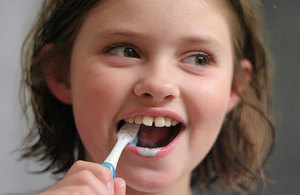Tooth decay among 5 year olds continues significant decline
The number of 5 year olds with tooth decay has dropped to its lowest level in almost a decade, according to a PHE oral health survey.

A girl brushing her teeth.
The oral health survey published today (Tuesday 10 May 2016) by Public Health England (PHE) reveals that less than 25% of the cohort suffers from tooth decay, a 20% drop since 2008.
This continues the downward trend seen since 2008, in the first oral health survey of 5 year olds asking parents to opt-in. In 2008, 31% of 5 year olds suffered tooth decay; in 2012 it was 27%. The pattern of dental health improvement among the age group shows the impact parents and carers can have in establishing good dental care habits from an early age.
Dr Sandra White, Director of Dental Public Health at PHE, said:
This is great news. However, one child with tooth decay is one too many and there is still much inequality in dental health around the country. Tooth decay is painful and too often results in teeth extraction, some under general anaesthetic.
This is further evidence that we can stop tooth decay in its tracks. Limiting sugary food and drink, supporting children to brush their teeth twice a day with fluoride toothpaste and regular trips to the dentist, will help prevent a great many more children suffering at the hands of tooth decay.
According to the survey an estimated 166,467 5 year olds suffer from tooth decay, compared with 177,423 in 2008.
While there has been a significant decline in tooth decay at a national level, there is still a great deal of regional variation. In the North West, a third (33.4%) of 5 year olds suffer from tooth decay, whereas only a fifth (20.1%) do in the in the South East. As with the 2 previous surveys, areas with higher levels of deprivation tend to have higher levels of tooth decay.
The proportion of 5 year olds who have had teeth removed due to decay was 2.5%, compared to 3.5% in 2008 – about 2,000 fewer children. Regional variation shows that only 1.9% of 5 year olds in the East Midlands have had tooth extractions due to decay, compared with 3.9% of children in Yorkshire and the Humber.
The survey also shows the average number of teeth affected by decay per child was 0.8, down from 1.1 in 2008. For the first time, data has also been collected across the survey on ethnicity and dental health.
The last 3 surveys have shown the dental health of 5 year olds is improving. There has been a 9% increase in the proportion of children with no obvious decay since 2008. Further analysis is needed to understand the factors that have contributed to this welcome trend. This will help local authorities identify the steps they can take to extend the improvement in decay levels to all sectors of their populations.
Background
-
The Oral health survey of 5 year olds examined the dental health of 111,500 children whose parents and carers opted in to the survey. This is 16.5% of the 5 year old population in England.
-
Local authorities (LAs) are now responsible for improving oral health and reducing health inequalities. PHE recommends LAs refer to the evidence-informed toolkit Local authorities improving oral health: commissioning better oral health for children and young people.
-
PHE recommends that dental health professionals refer to the latest version of Delivering better oral health: an evidence-based guide for the prevention of tooth decay.
-
Public Health England exists to protect and improve the nation’s health and wellbeing, and reduce health inequalities. It does this through world-class science, knowledge and intelligence, advocacy, partnerships and the delivery of specialist public health services. PHE is an operationally autonomous executive agency of the Department of Health. Follow us on Twitter @PHE_uk and Facebook.
Please contact Razeeb Ahasan razeeb.ahasan@phe.gov.uk or Naomi Ramage naomi.ramage@phe.gov.uk for further information. Out of hours telephone: 020 8200 4400.